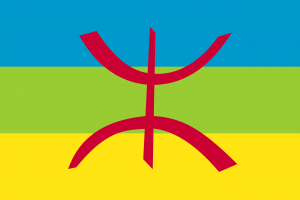Difference between revisions of "Language/Central-atlas-tamazight/Grammar/Conditional-Mood"
m (Quick edit) |
m (Quick edit) |
||
| Line 6: | Line 6: | ||
__TOC__ | __TOC__ | ||
<span link>Once you've mastered this lesson, take a look at these related pages: [[Language/Central-atlas-tamazight/Grammar/Adjectives|Adjectives]], [[Language/Central-atlas-tamazight/Grammar/Negation|Negation]] & [[Language/Central-atlas-tamazight/Grammar/Questions|Questions]].</span> | |||
== Overview == | == Overview == | ||
The conditional mood is used to express a hypothetical situation or an event that could happen in the future. It is also used to express a wish or a desire. In Central Atlas Tamazight, the conditional mood is formed by adding the suffix -ɣɣa to the verb. | The conditional mood is used to express a hypothetical situation or an event that could happen in the future. It is also used to express a wish or a desire. In Central Atlas Tamazight, the conditional mood is formed by adding the suffix -ɣɣa to the verb. | ||
| Line 31: | Line 33: | ||
<br><hr>If you have any questions, please ask them in the comments section below.<br>Feel free to edit this wiki page if you think it can be improved. 😎 | <br><hr>If you have any questions, please ask them in the comments section below.<br>Feel free to edit this wiki page if you think it can be improved. 😎 | ||
==Other Lessons== | |||
== | |||
* [[Language/Central-atlas-tamazight/Grammar/Plurals|Plurals]] | * [[Language/Central-atlas-tamazight/Grammar/Plurals|Plurals]] | ||
* [[Language/Central-atlas-tamazight/Grammar/Gender|Gender]] | * [[Language/Central-atlas-tamazight/Grammar/Gender|Gender]] | ||
| Line 45: | Line 45: | ||
{{Central-atlas-tamazight-Page-Bottom}} | {{Central-atlas-tamazight-Page-Bottom}} | ||
<span links></span> | |||
Latest revision as of 20:59, 27 March 2023
Hi Central Atlas Tamazight learners! 😊
In today's lesson, we will be exploring the conditional mood in Central Atlas Tamazight. We will look at how to form sentences in the conditional mood and how to use them in everyday conversations.
Once you've mastered this lesson, take a look at these related pages: Adjectives, Negation & Questions.
Overview[edit | edit source]
The conditional mood is used to express a hypothetical situation or an event that could happen in the future. It is also used to express a wish or a desire. In Central Atlas Tamazight, the conditional mood is formed by adding the suffix -ɣɣa to the verb.
Examples[edit | edit source]
- If I had more time, I would learn Central Atlas Tamazight. - Ɣer tafat n uɣilif, ɣef yiḍra Tamazight n Tmazɣa.
- I wish I could speak Central Atlas Tamazight fluently. - Ɣer tafat n ttɛɛnaḍ Tamazight n Tmazɣa s wawal.
Formation[edit | edit source]
The conditional mood is formed by adding the suffix -ɣɣa to the verb. The suffix -ɣɣa is added to the verb stem, which is the part of the verb that remains after removing the subject pronoun prefixes.
Examples[edit | edit source]
- To speak - ɛɛnaḍ
- To speak (conditional) - ɛɛnaḍɣɣa
Usage[edit | edit source]
The conditional mood is used to express a hypothetical situation or an event that could happen in the future. It is also used to express a wish or a desire.
Examples[edit | edit source]
- If I had more time, I would learn Central Atlas Tamazight. - Ɣer tafat n uɣilif, ɣef yiḍra Tamazight n Tmazɣa.
- I wish I could speak Central Atlas Tamazight fluently. - Ɣer tafat n ttɛɛnaḍ Tamazight n Tmazɣa s wawal.
Conclusion[edit | edit source]
We have now looked at how to form sentences in the conditional mood and how to use them in everyday conversations. We hope this lesson has helped you gain a better understanding of the conditional mood in Central Atlas Tamazight.
If you have any questions, please ask them in the comments section below.
Feel free to edit this wiki page if you think it can be improved. 😎
